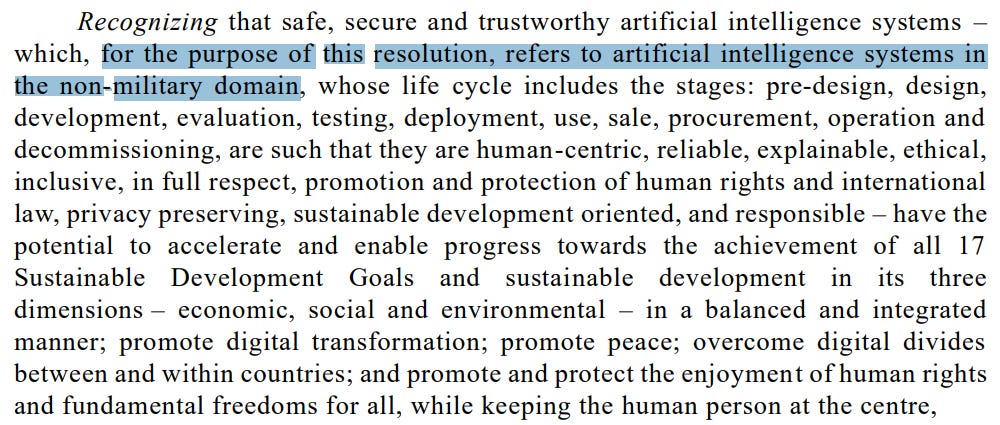A step towards global "safe, secure, and trustworthy AI"
Quick notes on some under-mentioned aspects on the UN resolution on AI, adopted on March 21 - military exclusion, digital literacy, bias prevention, diversity and equality, and labor market impacts
On March 21, the United Nations announced adoption of a resolution on AI. It’s worth reading the full text of the agreement, dated March 11 (only 8 pages; see https://undocs.org/A/78/L.49 and then choose your preferred language).
Overall, it has some good high-level principles and agreements on achieving “safe, secure and trustworthy artificial intelligence systems” and feels like a solid start to a world-unified perspective on governance of AI.
A few things which haven’t yet (so far as I’ve seen) been called out in the mainstream press caught my attention.
One notable point is the explicit exclusion of military domains. The scope for the resolution is limited to “artificial intelligence systems in the non-military domain” (emphasis added):
This exclusion may disappoint folks like PauseAI who have been advocating against use of AI for military purposes. However, it seems that efforts on global military use of AI are currently being coordinated separately.
The latest initiative is the Feb. 2023 “Political Declaration on Responsible Military Use of Artificial Intelligence and Autonomy“ (fact sheet, more info) which was agreed at an event hosted by the Dutch government. (The “Racism & Technology Center” protested with the Dutch government over its hosting of that event.)
To date, only 52 UN member states have endorsed the Declaration, i.e. only 27% of the current UN membership (193 member states). Failing to exclude the military domain in this resolution would have blocked reaching this agreement with the full UN membership on use of AI for all other domains. AI use in the military domain will need to be watched separately.
On the positive side, I spotted 4 commendable callouts:
1. Digital Literacy
The resolution calls out “the need to close the artificial intelligence and other digital divides; and increase digital literacy”
2. Bias Mitigation
The resolution highlights the importance of “protecting individuals from all forms of discrimination, bias, misuse or other harm, and avoid reinforcing or perpetuating discriminatory or biased applications and outcomes”, “analysing and mitigating bias” and ”combating algorithmic discrimination and bias”:
3. Diversity and Equality
The resolution proposes to close the “gender digital divide” and to “mainstream a disability, gender and racial equality perspective”:
Addressing ableism, sexism, and racism is commendable, and it’s great to see the importance of equality in these aspects recognized and included. However, it’s a little disappointing not to see other aspects of bias and equality which many (including me) also consider important. Most likely, universal global agreement on “mainstreaming” equality perspectives on the other ”isms” was not achievable within the targeted timeframe for this resolution, so they were not included.
4. Impact on Labo(u)r Markets
The resolution “encourages” work to identify and mitigate impacts of AI on labor markets, especially in developing and the “least developed” countries:
All four of these aspects of the UN Resolution on AI (digital literacy, bias mitigation, diversity and equality, and labor market impacts) are highly relevant to AI in general and to ethics of using generative AI for music in particular. PART 2 in our article series is coming out this week, including an overview of international and regional standards and guidelines on ethics of AI. Follow me or or subscribe to our
publication to be notified when PART 2 is out (if you haven’t yet seen them, do check out the intro and Part 1) 😊 See you there!






